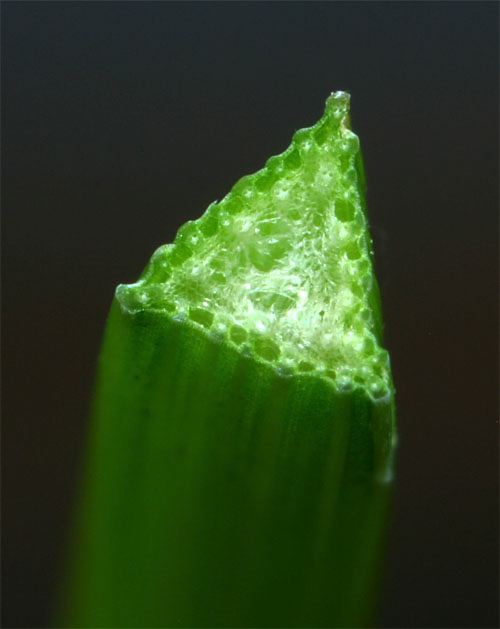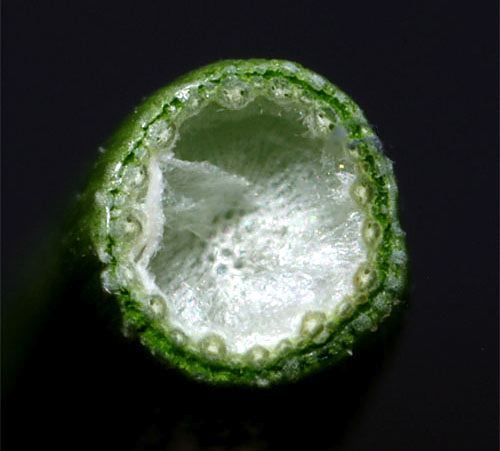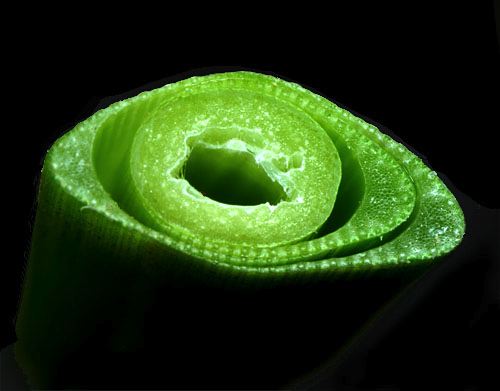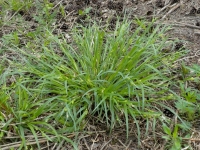What is a sedge?
Sedges are relatives of rushes and grasses. The sedge family, Cyperaceae, rush family, Jucaceae, and the grass family, Poaceae, are all in the order Poales. Sedges and rushses differ from grasses in many ways that require a technical knowledge of botany; however, there are also some simple ways to tell them apart. Grass stems are elliptical (or round) and hollow with swollen nodes, sedge stems are triangular, and rush stems are round. Grass leaves are in ranks of two (leaves are on opposite sides of the stem and lie within the same vertical plane) while sedge leaves are in ranks of three (leaves are lie within 3 different planes), rush leaves are very small or absent. In general grasses grow in warmer, dryer, more open places and sedges and rushes grow in cooler, wetter, more protected locations but there are thousands of exceptions.
Here is a helpful saying: Sedges have edges, rushes are round, grasses are hollow, what have you found?



Sedges generally have inconspicuous flowers. The flowers may be bisexual (having both male and female parts) or unisexual (having separate male or female flowers, not both). When they are unisexual the plants are monecious, meaning they have both male and female flowers on the same plant. Each flower produces one seed, a fruit called an achene.
Carex blanda Description
Each Common Wood Sedge plant forms a somewhat sprawling leafy clump up to 45cm wide with flowering stems (culms) reaching about 30 cm high. The leaves are about 8mm wide and 20 cm long and bright green with a groove down the center. The inflorescence has a cluster of male flowers on the end in what is called a staminate spike or spikelet while lower down 2-4 female pistillate spikelets are attached. The picture below shows an inflorescence with two female spikeletts bearing seeds (achenes) and a small male spikelet at the tip between them. Flowering occurs in early spring and pollination is by the wind. To accurately identify most sedges one has to look at the flowering parts and seeds under a dissecting microscope! To learn more about sedge identification consider taking a class at the UWM Field Station or pick up a copy of Flora of Michigan (Edward Voss) or Wisconsin Sedges (Andrew L Hipp. An electronic copy can be found here) from the library.
Several sedges, including C. blanda are semi evergreen. Most of each leaf is turned brown by cold damage but close to the ground the leaves are green all winter long. In years with a lot of snow the leaves are insulated from the coldest weather and a larger portion of the leaves stay green throughout the winter.
Range, Habitat, and Cultivation.
Common Wood Sedge is found from Manitoba down to Texas and almost every state (and Canadian province) east of this longitude. Within Wisconsin it is mostly restricted to the lower 2/3 of the state. It is common in both high quality and degraded woods, openings and clearings in woods, weedy and disturbed meadows and old fields, lawns and gardens. Common Wood sedge prefers partial shade but may also grow in full sun. A true opportunist, it is not particular about soil type and is just as happy in clay or loam as it is in rocky soil. Although sometimes described as weedy, this plant's so-called weedy-ness makes it an important pioneer species that protects soil from erosion in a variety of niches where other plants are less successful. I'm always happy to see it eking out a living in the forgotten slivers of city soil, in the middle of a garlic mustard infested woods, or bravely representing native flora in the midst of highly manicured suburban landscape full of European and Asian plants. This plant would be a worthy candidate as an experimental groundcover or lawn substitute in a semi shaded area where there is not more than occasional foot traffic.
Wildlife Value
As one of handful of sedges that can thrive in disturbed areas this sedge plays an important role in protecting soil and providing food for wildlife, especially wildlife that co-evolved with the North American Carex species. A number of birds including turkey, grouse, woodcock, and songbirds eat the seeds as do grey squirrels and white footed mice. Rabbits and deer consume its leaves and stems as well as a wide variety of insects, some of them Carex specialists. To see a list of 14 different moth and butterfly caterpillars that need native sedges for food click here.





